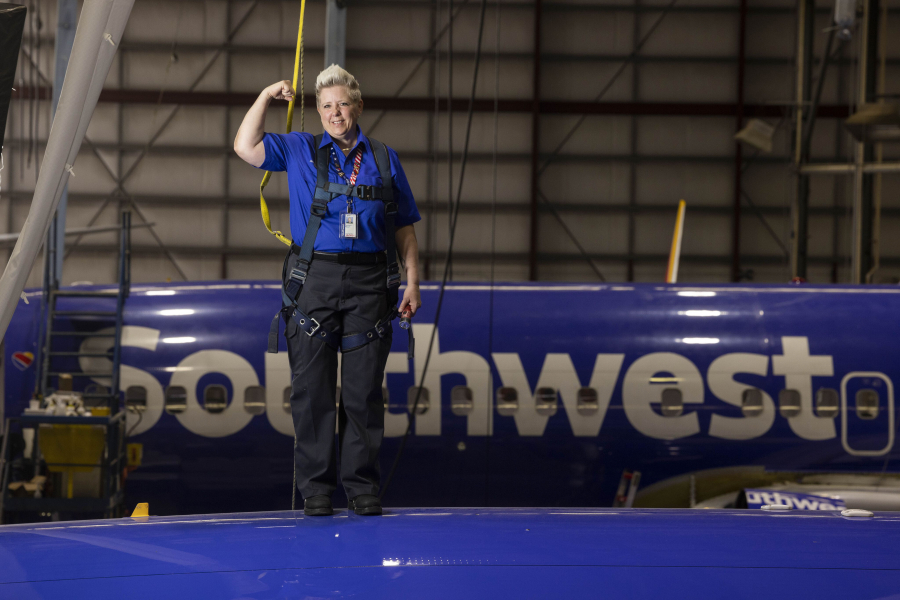Jennifer Morgan’s day at work at Southwest Airlines includes strapping herself to a harness and standing on top of a Boeing 737.
She does it while sporting her signature tall blonde hair and a Southwest blue button-up shirt. The 52-year-old is known as “Powder” to her colleagues — almost all of whom are men. She’s an inspector for Southwest’s technical operation and she sees herself as one of the guys.
“Everybody treats you, even if you’re older than them, they treat you like a little sister,” Morgan said. “They always check on you. Not that I need to be checked on. There’s no animosity as you would think in a lot of fields.”
In a career that sees the least amount of women representation for the aviation industry, of all aircraft maintenance technicians, women only make up 2.6% of the field, according to Women in Aviation International.
The advocacy group’s 2022 recommendations report said that Boeing forecast over the next 20 years, 626,000 maintenance technicians will be needed worldwide.
Maintenance technicians are often the people behind the scenes, diagnosing mechanical and technical issues of different aircraft.
On a perfect day, according to Stacey Rudser, president of the Association for Women in Aviation Maintenance, the job is designed to be invisible. Most of the work is done at night when planes are grounded, Rudser said.
“If there’s something we need to resolve on a flight, usually a passenger can’t really see us, like changing a tire on certain types of aircraft,” Rudser said, noting the career’s visibility problem. “You and the passengers aren’t gonna see that.”
Rudser said the job goes unnoticed, where it has become easier to point young girls to more visible careers such as pilots or engineers. It’s a profession that is still seen as blue-collar when Rudser would rather think of it as “gray-collar,” based on how sophisticated the aircraft maintenance technicians’ work has become.
Aviation is a culture that hasn’t quite caught up to be a welcoming environment for women, Rudser said, but the work being done now is more than it has ever been before.
Evie Garces, 42, American Airlines ‘ vice president of line maintenance, is the first Hispanic woman to take on the leadership position at American. Her parents were immigrants from the Dominican Republic and she grew up in New York.
An aviation high school caught her attention and she took the New York City subway at 14 years old to get to school every day. Garces later earned her airframe and powerplant license.
Out of high school, she worked at Tower Air, a now-defunct airline once based out of John F. Kennedy International Airport in New York.
“My first paycheck was more than what my Dad made,” Garces said. “That was an eye-opening experience for me because not only was I making more than my Dad, but I was making more than my Dad straight out of high school without any college education.”
At American, starting salary ranges based on contracts range from $78,000 to $80,000 and top of scale could be anywhere from $119,000 to $121,000 within nine years. The range represents whether people work in line or base maintenance and there’s an additional premium to work line maintenance. Wage scales based on the contract and is a nine-step scale until reaching a max at nine years.
At Southwest, the current starting rate for aircraft maintenance technicians is $30.86 with the opportunity for future increase per applicable collective bargaining agreement wage scale, as well as opportunities for overtime, shift pick-ups and shift premiums.
Garces has been with American for 22 years. She never backed down from a challenge.
“I was focused on becoming the best mechanic, becoming the best supervisor, that if there was negativity around me, it didn’t slow me down because I was trying to be the best at what American was paying me to do,” Garces said. “But there were challenges.”
One of those challenges was being pregnant at 39 and working.
“I just didn’t know how to be pregnant out on the hangar floor,” Garces said. “I didn’t see any women that were pregnant. It almost felt to me like, ‘You can’t do it, because no one does it.’ How accommodating are people going to be? Do I even want them to be accommodating? I can do the work.”
Another barrier is cost, a similar barrier to what people face to become a pilot.
Rudser said the cost of training for maintenance technicians varies on where training comes from. Community college programs run generally not as expensive, but vary between schools, Rudser said. Private trade schools are a much faster option for women interested in flying.
According to Vocational Training HQ, an associate degree in aircraft maintenance can be anywhere from $8,000 to $30,000 and a bachelor’s can cost $20,000 to $80,000.
Written tests run around $125 each, Rudser said. There are also three oral and practical tests with varying prices depending on where you’re taking them. Total testing costs can be around $5,000 to $6,000.
“I know so many people who have gotten through school and between test anxiety and cost, they never get that license,” Rudser said.
The industry is also aging. A 2022 pipeline report from the Aviation Technician Education Council said the average Federal Aviation Administration mechanic is 53. Females are typically younger, the average age of a female mechanic is 45.
Despite the hurdles, these women leaders are encouraging more young girls to take part in the industry than ever before. Morgan said the largest reason she believes girls don’t see themselves as maintenance technicians is self-doubt.
“Nobody was born with that knowledge and (women) have to remember that every single person out there started with no knowledge of the aircraft,” Morgan said. “Somebody came in and took them under their wing, and they taught them. There are people that will take you under their wing no matter what.”



